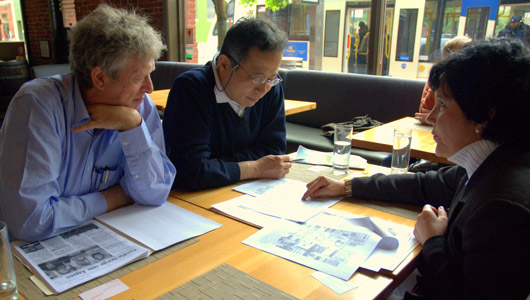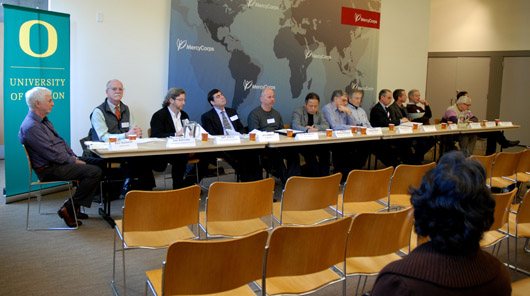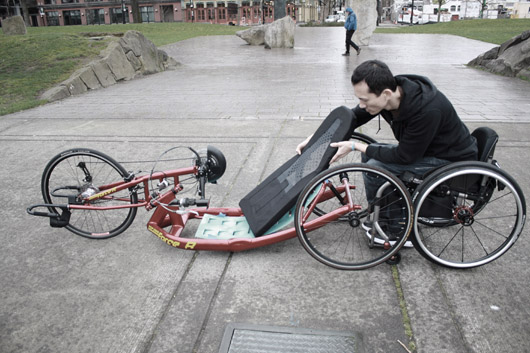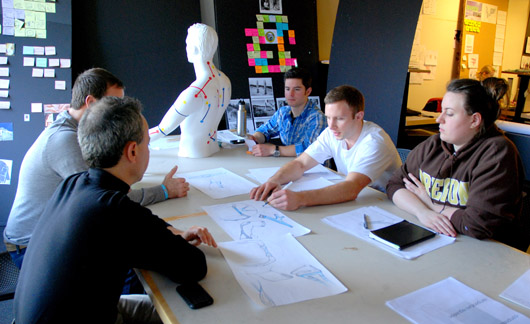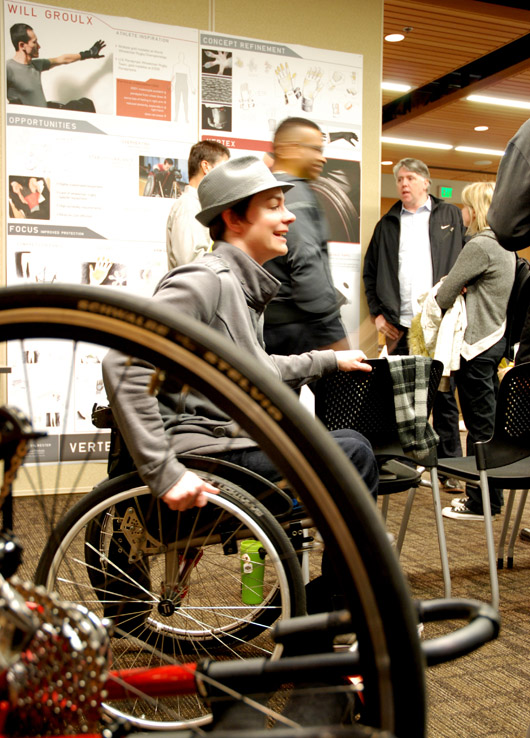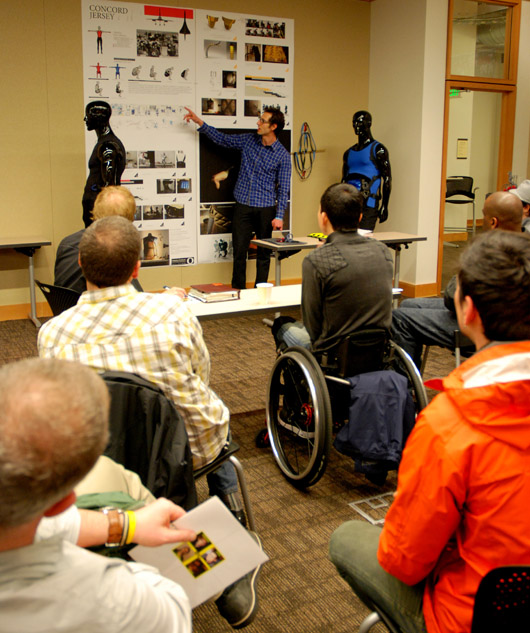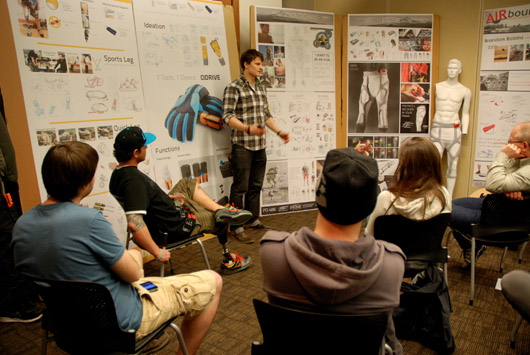Brad Cloepfil Designs for Place
By Sabina Samiee
Architect Brad Cloepfil, AIA, released the book, Allied Works Architecture / Brad Cloepfil: Occupation in 2011.
[Text by Sandy Isenstadt, Kenneth Frampton.Photographs by Victoria Sambunaris.Hardcover / Slipcase / Clothbound440 pages, Illustrated throughout.$85.00 (ISBN: 9780980024258)]

Internationally recognized along with his firm, Allied Works Architecture, Cloepfil and his team have designed a number of influential buildings and master plans for major cultural, educational, commercial and residential clients. The book is a “comprehensive monograph” that covers Allied Works’ important commissions from 1994 to 2011, including the world headquarters for Wieden+Kennedy (2000), the Contemporary Art Museum St. Louis (2003), the Booker T. Washington High School for the Performing and Visual Arts (2008), the Clyfford Still Museum (2011), and the forthcoming National Music Centre of Canada in Calgary, Alberta (2014) — and contains an extensive selection of images documenting each project. These include context photography by Victoria Sambunaris, sketches by Cloepfil, physical models, and architectural drawings. Called “highly readable dialogues,” this collection effectively illuminates numerous aspects of Cloepfil’s approach to architecture as well as revealing a variety of personal elements that influence and inform his work.

On April 12, 2012, Cloepfil came to the University of Oregon in Portland at the White Stag Block to deliver his lecture “OCCUPATION.” The title of his lecture was borrowed from his recently published book, a choice presumably made as he spoke about the designs incorporated into the text. Speaking to a small, intimate audience, the scale was human, the conversation approachable and the discourse provocative and engrossing. In a way, this setting was very much akin to Cloepfil’s architectural practice, his reasoning of grounding a connection, in this case, between audience and speaker (rather than earth and building). With such a closely woven experience, Cloepfil’s advocacy for a keen recognition of setting and environment was very apparent. His carefully articulated lecture was absorbed by grateful, autograph seeking students together with a calm and interested audience that melded students and community designers interested in hearing firsthand the eloquence of this University of Oregon architecture alumnus [BArch ’80].
As an architect, Cloepfil, a sort of Portland design deity, rarely needs more introduction than to mention that he is principal founder of Allied Works Architecture, with offices based in both Portland and New York. His name is synonymous with positive downtown monumental, restorative projects of immense creativity and contribution to the city and landscape in which they are integrated. His reputation as a self-assured maverick innovator somewhat precedes him; his penchant and ability to soothingly deliver eloquent and linguistically stunning monologues on his designs and theory also is well-known. I was intrigued by this combination of personality and practice, and welcomed the opportunity to join the group of Cloepfil disciples who converged on the White Stag April 12. So it was on that Thursday evening that I assembled with an attentive White Stag audience. Comfortably sitting in darkness, we awaited great things and slide images of inspiring vision.

Cloepfil began by saying architecture is an “act that amplifies insight into a place.” He urged his audience to see a very specific environmental context to building design and to see things one would not normally see by really looking at “place, noticing order, forces at play, qualities not immediately obvious, characteristics and conditions.” We learned that Cloepfil finds Oregon’s hazelnut orchards to be his “favorite architecture”; the texture and
quality of light that the rows of trees present “create the opportunity for action” and the “possibility of response.”
Using the brilliant word “ENTWINEMENT,” (which to me sounds like a beautiful almost sculptural illusionary portmanteau for architectural theory), Clopefil spoke of his Maryhill Overlook as “building a wall ….as a reference point that would measure and magnify everything around it.” Sort of entwining the land, the light, the
aesthetic of design and the materials. It is an intentional method to inspire and provoke a thought: “what impact can architecture have in a landscape?”
Addressing his design ideals, Cloepfil says, “walls” have the ability to “weave a pattern;” and “landscape and light” can bring the inside outside and vice versa. Recognizing that, we can proceed to the architect’s foremost concept that a structure “should knit itself” into its environment, as his Dutchess County Residence Guest House (New York) establishes its location and occupies a deciduous forest becoming “a bridge for the intimate acts of living.”

Most importantly, continues Cloepfil, despite the use of materials like steel, glass and wood, the very ingredients of the design must emerge, flow, and wander in the natural landscape not limiting nor preventing a sense of the natural environment which must prevail and “hold to the ground.”
Perhaps it was Cloepfil’s admission of his love for the “American landscape,” an urban landscape, he says, that is inherently “beautiful” that gently coaxed his audience to sit farther forward on their seats, listening even more intently. The slide image backdrop was now a lot in St. Louis, bare and flat mowed grass: to some, devoid of inspiration. To Cloepfil, this “urban prairie of undifferentiated space” is boundless and gives the opportunity to the architect to explore a “ribbon and rodeo of planes” of a structurally transparent and responsive environment. Cloepfil spoke passionately of possibility in such a seemingly barren cityscape: he sees a monumentality in the sky, and he imagines an architecture that will “hold this space”, a space of both “relic and ruin,” of “grace and offering.”
When Cloepfil turned to commissions not won (with the graciously unpretentious comment, “and these are projects we did not get….”), he showed work imagined yet not completed. His ideas still realistically leapt off the slide screen in carefully crafted models, the barest of sketches some almost Rodinesque in their simplicity and single line use.
Throughout the image | model tour of Allied Works three dimensional visions, Cloepfil’s adoration of light and the bridging of structure in a space remained consistently evident: his “series of walls that dance across the landscape” that “cantilever and transform….filter light and space” all contributing to our understanding of this individual as ultimately concerned with the quality of a place. Cloepfil is not just enamoured with structural studies, the formulation of a working plan and building: his methodology transcends this to take a design into a matrix of structure and space where even the seams and crevices of a wall achieve relevance.
Cloepfil introduced us to his use of EMBEDMENT, a building holding its ground or being embedded in the ground and under a boundless sky. He spoke of using the structure as an element that would be brought to the ground creating one solid place where the qualities of light and the rendering of a surface will be given the chance to interact and create a play of light and shadow. There exists a pressing or rooting to the earth that enables the structure to rise up– every surface infused with importance. EMBEDMENT becomes a key element of Cloepfil’s aesthetic: the ability to produce a grounded yet watery-shimmer of light with the placement and exploration of materiality.
AMPLIFICATION, says Cloepfil, as he continued on his detailed design discourse, is the ability of a building to amplify something (a condition) to elevate a concept, to suppress other things. Somewhat abstract, AMPLIFICATION was embraced by Cloepfil’s proposal for the National Music Centre of Canada (Calgary) where the strong Alberta landscape situated between soaring mountain and vast prairie called for the weaving of structure and land and yet to still needed to manifest a significant cultural appreciation. About the NMC, Cloepfil speaks of the material quality that “creates this world” and how the “interior walls move with a geometry” as light scampers at will up and down the walls ”unifying all.”
Drawing his lecture to a close, Cloepfil said “boldness is required to expand human and natural resources.” A sense of humility creates architecture by “allowing the influence of other factors that enrich and extend the life of a building.” It is this “humility” in design that posits a question of what architecture can really offer. Says Cloepfil, it “creates an experience that enriches the life of the place.”
As for us here in downtown Portland, and those who pass by Cloepfil’s much-lauded Wieden+Kennedy building, why not look around, perhaps more than usual while on a daily trek? On those days when I wander our cherished P-town, I am usually in search of an early morning cappuccino, with my eyes aware only of the Oregon gray skies and dim morning light, my step full-steam ahead to avoid impending rain and work-rushed vehicles. I have to say Cloepfil’s insights have somewhat altered my state of mind. Cloepfil says, yes, the Oregon skies are gray, and yes, he unabashedly uses concrete (“for its malleability and earth-like quality”) which might magnify Oregon’s spectacular calm gray-ness. And this seems to be the point, Cloepfil’s designs sit firmly on their
ground, confident, self-assured, permanent, strong and vital—but different and attractively stand-alone in dramatic and assertive ways. A part of the built environment, Cloepfil’s buildings clear of distractions around them creating a space that then fills with light, is receptive to movement and sound, and embraces the activity takes place within.
Cloepfil mentioned in his lecture that his Maryhill Overlook is a reference point in the landscape, “a measure and a magnifier of everything around it.” Strike out a little, venture east of Portland far up the Columbia River Gorge and go see Allied Works’ Maryhill Overlook. Grapple with this ribbon of concrete that seems to push up from the flat, expansive bluff to lie open and inviting to the limitless skyscape and imagine a connection—the bond between earth and sky, the seamless reach of silverish poured concrete beaming up into the vast Oregon sky. It is a basking mirror of the light and landscape of the Columbia River Gorge’s natural greatness, reflecting the illumination and cloud cover of an ever-changing vault of atmosphere.
As the human element that comes into Cloepfil’s created spaces, we get to experience with a depth and emotion, that sense of being enveloped by architecture while it assists in how we interact with our surroundings. Cloepfil’s lecture urged us to look outside the expansive skins of glass fenestration to the wonder and vastness of nature and sky, or observe the movement on a street, the bustle of daily life and to see a connection between the interior and the exterior. At the forest-snuggled Dutchess Residence Guest House, glass walls encourage interaction and acknowledgement of trees, light and space. As the architect notes, these designs seek to recognize the transparency of flowing through a space, light cascading down to dance in a path, chasing or following us with shadow, and immersing our body in illumination (even on a gray day, there is light). Cloepfil’s designs don’t just invite the sunlight in, it is given its own space—it owns and occupies and moves around the building just as people will. And perhaps is given center stage.
Cloepfil’s walls of glass, his bridal-like screens of trees behind from which peer facades, walls and windows; his wrapping, meshing, and giving of a place all contribute to an experience where we, as his receptive audience and the ultimate user’s of his work, get to “occupy” in the best way possible. The human element is invited to occupy these spaces and places of Cloepfil’s creation, and as Cloepfil explains to flow into, out of and around buildings of concrete, glass, steel, and slate combined in a way that gives us a sense of place, context and of relating to and being connected with our environment. While inside a Cloepfil building are we given a chance to take the pulse of a city, to enjoy the spontaneous energy of a day, to relish the lives of clouds, and the expanse of a environment. His integration of interior and exterior spaces seem to advocate for our recognition of more than ourselves. It is architecture that brazenly requests we look around and notice “place.” While Cloepfil somewhat apologetically referred to “place” as his inspiration and the grounding element in all Allied Works designs, he nonetheless called it an “old fashioned term.” It is “place”, says Cloepfil that gives us the sense of belonging, being connected, and having a perception of existing in the continuity of location. Designing for “place” he says, is absolutely key.

